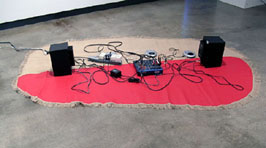9/5/2005
Elisabeth Penker
HTTP, London
De-Grammatical: Rhythm and Language Transformation. The artist is questioning visual structures in relation to language. By decoding visual systems and displacing rhythm and language into a non-linear structure, Penker is showing the commonality of Modern Art and First Nation Art. It is of particular interest how polysynthetic languages which are common in First Nation Languages, compare to Indo-European languages and how visual languages relate to grammar and syntax.

De-Grammatical: Rhythm and Language Transformation
HTTP gallery is pleased to present Austrian artist Elisabeth Penker's first solo exhibition in the UK. In her work Elisabeth Penker is questioning visual structures in relation to language. By decoding visual systems and displacing rhythm and language into a non-linear structure, Penker is showing the commonality of Modern Art and First Nation Art. It is of particular interest how polysynthetic languages which are common in First Nation Languages (i.e. there is no clear distinction between a word and a sentence), compare to Indo-European languages and how visual languages relate to grammar and syntax.
At the turn of the last century the Futurists introduced sounds of motors and vocals as instruments for orchestras, which consequently influenced Dada and Fluxus movements that pioneered the early days of electronic music. The Dadaists phonetically experimented with grammatical structures. Penker combines these different approaches to rhythm and language transformations. For her exhibition at HTTP gallery, Elisabeth Penker has developed a new sound piece Die Bildhauerin (The Sculptor [fem.]), a deconstruction of rhythm and syntax in a non-linear repetitive multi-channel matrix. Die Bildhauerin (The Sculptor [fem.]) breaks up the grammatical structure of the word "DIE-BILD-HAU-ER-IN" into minimal units which are called morphemes. The composition is arranged with the sound of two stone masons, chiselling this broken grammatical structure into a wall. The morphemes build the base rhythms of the composition.
For the opening, Penker will perform live to the composition Die Bildhauerin (The Sculptor [fem.]). The performance is supported by a sonic structure constructed of wood and various industrial floor materials which are amplified and function as instrument and interactive sound sculpture during the exhibition.
The audience can play on the sonic structure of the sound piece, and this is combined structurally with the conceptual logic of Luigi Russolo’s (1913) Manifesto, The Art of Noises and the technical methodology of Jack Foley’s recordings for films.
Elisabeth Penker, born 1974 lives and works in Vienna recent exhibitions include:
2005 “The Red Thread†Howard House Contemporary, Seattle
2004 "Sound Studioâ€, Gallery Priestor for Contemporary Arts, Bratislava, SK
“Born to Be a Star (curated by Ursula Probst)â€, Künstlerhaus, Vienna
2003 “Sound System", Salzbuger Kunstverein, Salzburg, A ; Liste 03 with Galerie Michael Hall, Vienna (solo) “Selected Sound Sculpturesâ€, Galerie 5020
Salzburg /A (solo)
2002 , “Butterfly reached the sound-barrierâ€, Kibla New Media Center, Maribor, SL; “Waiting for the Ice Ageâ€, Galerie Georg Kargl, Vienna; “hear the artâ€, Kunsthalle Exnergasse, Vienna
2001 Kunstbüro, Vienna (solo) “First Story-Women Buildingâ€, Galerie do Palacio Cristal, Porto (curated by Ute Meta Bauer) and “(untitled) 654321", Kunsthallen Brandts Klaedefabrik, DK (curated by Jacob Fabricius & Tommy Lund)
“De-Grammatical: Rhythm and Language Transformation†is supported by the Austrian Cultural Forum.
Image: "Untitled (Moscow/Cracky Walls)" 1999-2004, 2 active speakers, 3 CD players, mixing board, leather and burlap, courtesy: Galerie Michael Hall, Vienna
Opening: Tuesday 10 May 2005 7-9pm
http gallery
Unit A2, Arena Business Centre,
71 Ashfield Rd,
London N4 1NY
gallery open Friday-Sunday 12-5pm



